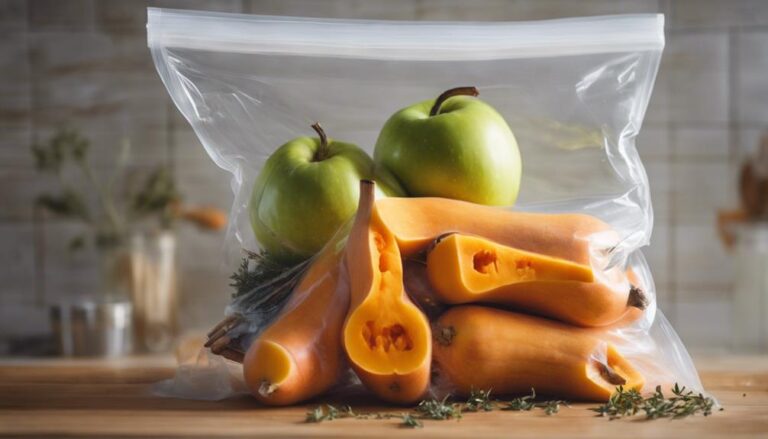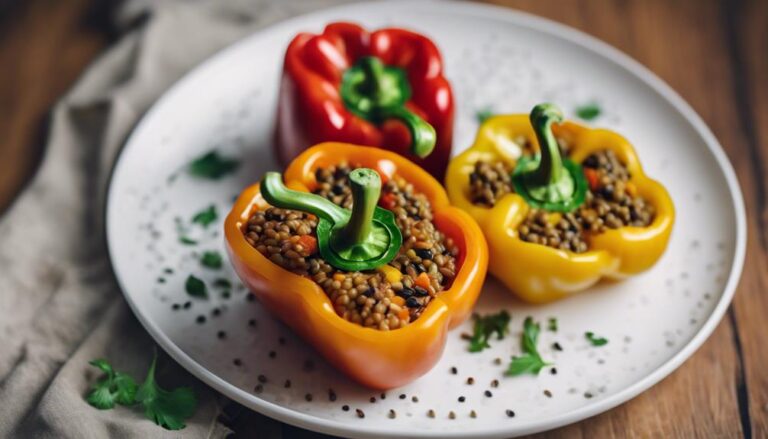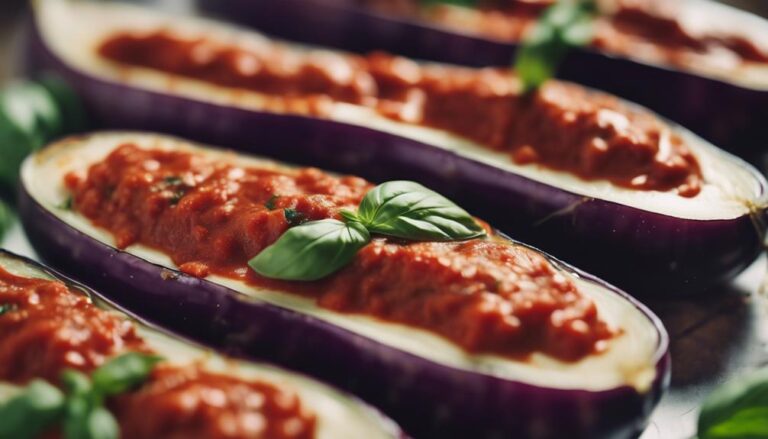Sous Vide Pickled Seasonal Vegetables
Enhance your seasonal vegetables with a modern twist using sous vide pickling. Seal your veggies with flavor-boosting ingredients in airtight bags before cooking in a water bath for best infusion. The controlled low temperature guarantees gradual flavor melding while retaining textures. This method maintains crispness while infusing tangy and spicy pickle flavors, offering a delightful crunch.
What You Will Learn Here
- Sous vide enhances natural vegetable flavors through controlled low-temperature cooking.
- Vacuum-sealing maintains crispness while infusing pickling flavors for a satisfying crunch.
- Gradual flavor infusion retains impressive textures in pickled seasonal vegetables.
- Tangy and spicy flavors are infused in each bite through sous vide pickling.
- Precision cooking ensures consistent results with enhanced taste profiles.
Origin of Sous Vide
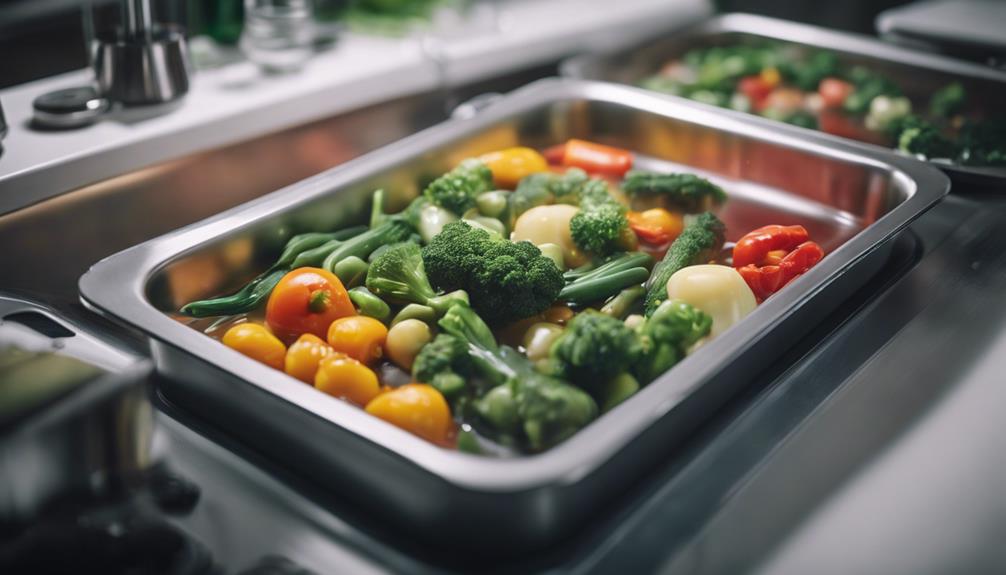
Sous vide, originating in the late 1960s, revolutionized culinary techniques by introducing a precise temperature-controlled cooking method.
This cooking technique has since evolved, gaining popularity for its ability to enhance flavors and textures while maintaining the integrity of ingredients.
Today, sous vide is widely used in professional kitchens and home cooking, showcasing its versatility and adaptability in modern culinary applications.
Sous Vide History
The technique of sous vide cooking, known for its precise temperature control and ability to enhance food flavors, traces its origins to the work of French and American engineers in the mid-20th century. The benefits of sous vide include consistent results, retention of nutrients, and the ability to infuse flavors deeply into foods.
To achieve sous vide cooking, specialized equipment is required, such as a vacuum sealer to package the ingredients and an immersion circulator to precisely control the water temperature. These early developments in sous vide technology paved the way for chefs to explore new culinary possibilities, revolutionizing cooking methods and elevating the dining experience.
As sous vide continues to evolve, its history remains rooted in innovation and a pursuit of culinary perfection.
Cooking Technique Evolution
Originating from early developments in culinary technology, the evolution of cooking techniques has been marked by a relentless pursuit of precision and innovation, exemplified by the emergence of sous vide cooking. The journey of culinary technology advancements has seen a shift towards more precise and controlled methods. Below is a table highlighting key evolutionary cooking methods and culinary technology advancements:
| Evolutionary Cooking Methods | Culinary Technology Advancements |
|---|---|
| Roasting | Oven with temperature control |
| Boiling | Induction cooktops |
| Smoking | Electric smokers |
| Sous Vide | Immersion circulators |
These advancements have not only revolutionized the way we cook but have also paved the way for techniques like sous vide to thrive in modern kitchens.
Modern Culinary Applications
Innovative culinary applications have transformed the way chefs approach cooking techniques, with one standout method being sous vide. This technique, originating in the 1970s as a part of molecular gastronomy, involves cooking vacuum-sealed ingredients at precise temperatures for extended periods.
Sous vide has revolutionized the culinary world by ensuring consistent results and enhancing flavors. Chefs now combine this method with fusion cuisine, blending diverse culinary traditions to create unique and exciting dishes. The controlled environment of sous vide allows for the infusion of flavors and the precise cooking of ingredients, resulting in dishes that are unparalleled in taste and texture.
Key Ingredient Pairings
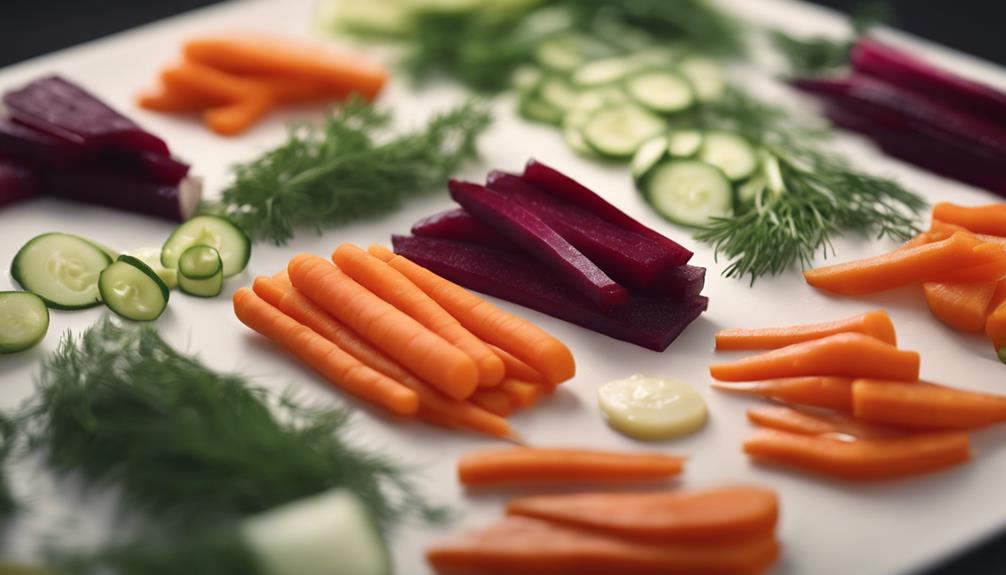
Wondering which ingredients complement the flavors of your Sous Vide Pickled Seasonal Vegetables best? To enhance the taste of your dish, consider these key ingredient pairings:
- Citrus: Adding a touch of citrus such as lemon or lime zest can enliven the flavors of the pickled vegetables, providing an invigorating contrast.
- Fresh Herbs: Incorporating fresh herbs like dill, cilantro, or parsley can introduce a layer of freshness and complexity to the dish.
- Spices: Experimenting with spices like cumin, coriander, or red pepper flakes can add depth and a hint of warmth to the pickled vegetables.
- Sweetness: Balancing the tanginess of the pickled vegetables with a touch of sweetness from honey, maple syrup, or agave nectar can create a harmonious flavor profile.
Trending Vegetable Sous Vide Dishes
Explore the latest vegetable sous vide trends with dishes like:
- Vegetable Medley Sous Vide
- Spicy Carrot Sous Vide
- Zesty Beetroot Sous Vide
These innovative recipes offer a fresh take on traditional cooking methods, infusing flavors and textures in unique ways. Elevate your culinary experience by trying out these trending vegetable sous vide dishes today.
Vegetable Medley Sous Vide
When preparing a vegetable medley sous vide, consider combining an assortment of fresh seasonal vegetables for the best flavor and texture. Here are some tips to elevate your vegetable medley sous vide:
- Variety: Use a mix of vegetables like carrots, bell peppers, zucchini, and cherry tomatoes to add color and flavor diversity.
- Consistent Cuts: Make sure all vegetables are cut to a uniform size to promote even cooking.
- Seasoning: Experiment with different herbs and spices to enhance the taste profile of the dish.
- Cooking Time: Adjust the cooking time based on the density of the vegetables to achieve the desired tenderness while retaining their natural flavors.
Spicy Carrot Sous Vide
For a bold and flavorful twist on sous vide vegetables, consider delving into the trending dish of Spicy Carrot Sous Vide. This dish combines the earthy sweetness of carrots with a fiery kick of spice, creating a unique and memorable culinary experience.
Markdown list:
- Carrot Preservation: Sous vide cooking helps preserve the natural flavors and nutrients of carrots, resulting in a vibrant and fresh taste.
- Spicy Infusion: By infusing the carrots with spicy seasonings during the sous vide process, you can elevate their flavor profile and add a tantalizing heat to the dish.
- Trending Dish: Spicy Carrot Sous Vide is gaining popularity for its innovative take on traditional carrot dishes, appealing to those seeking new and exciting flavor combinations.
- Versatile Ingredient: Carrots are a versatile vegetable that can absorb flavors well, making them ideal for bold and spicy infusions in sous vide cooking.
Zesty Beetroot Sous Vide
Amplify the bold flavors of beetroot with a zesty twist through the innovative culinary technique of sous vide cooking. This method allows the beetroot to retain its natural earthy essence while infusing it with vibrant and invigorating flavors.
Here's how to elevate your beetroot sous vide game:
- Marinate: Pre-sous vide, marinate the beetroot in a blend of tangy turnip juice and citrus zest to enhance its depth of flavor.
- Temperature Control: Maintain precise temperature control during sous vide to safeguard the beetroot's texture remains perfectly tender yet firm.
- Finishing Touch: After sous vide, add a invigorating crunch by incorporating crisp cucumber slices for a delightful textural contrast.
- Sealing in Flavors: The sous vide method seals in all the zesty and earthy flavors, resulting in a harmonious blend that will tantalize your taste buds.
Sous Vide Temperature Guidelines
When it comes to sous vide cooking, understanding ideal temperatures, mastering precision techniques, and controlling temperature are key factors for successful dishes.
You must carefully consider the recommended sous vide temperatures to achieve the desired doneness and texture in your vegetables.
Precision in maintaining the right temperature throughout the cooking process is essential for consistent and delicious results.
Optimal Sous Vide Temps
To achieve perfectly cooked and flavorful vegetables using sous vide cooking, maintaining the ideal temperature is crucial. When sous vide pickling seasonal produce, precise temperature control guarantees excellent flavor infusion.
For most vegetables, temperatures between 183°F (84°C) and 190°F (88°C) work well. Cooking times vary based on the type of vegetable – firmer vegetables like carrots may need 45-60 minutes, while softer ones like zucchini may require just 20-30 minutes.
Experiment with temperatures within the recommended range to find your perfect balance of texture and taste. Remember, sous vide cooking is all about precision, so don't hesitate to adjust the temperature and cooking times to suit your preferences.
Enjoy the delightful flavors that sous vide pickled seasonal vegetables can bring to your table.
Precision Cooking Techniques
Maintaining precise temperature control is pivotal for achieving ideal results when employing sous vide cooking techniques, particularly when considering specific temperature guidelines for different types of foods. Temperature precision is at the heart of sous vide benefits, allowing for consistent and controlled cooking.
This innovative method involves sealing ingredients in airtight bags and cooking them in a water bath at precise temperatures for extended periods. The controlled environment guarantees even cooking and flavor infusion, resulting in tender and flavorful outcomes.
Temperature Control Importance
For best results in sous vide cooking, precise temperature control is essential to ensure consistent and flavorful outcomes. Temperature accuracy is a cornerstone of sous vide benefits, guaranteeing that your food is cooked perfectly every time.
By maintaining a precise temperature throughout the cooking process, you can achieve ideal flavor retention in your pickled seasonal vegetables. This method not only enhances taste but also contributes to food safety by eliminating the risk of undercooking.
Sous vide cooking allows you to control the exact temperature at which your vegetables are cooked, resulting in a more uniform texture and taste. Embracing the precision of temperature control in sous vide cooking is key to elevating your culinary creations to a new level of excellence.
Final Thoughts
Reflect on the overall process and results of your sous vide pickled seasonal vegetables to evaluate the success of your culinary experiment.
The flavor infusion achieved through sous vide cooking was exceptional, as the vegetables absorbed the pickling spices and brine thoroughly. The controlled low-temperature cooking method allowed for a gradual infusion of flavors, resulting in a well-balanced taste profile that enhanced the natural flavors of the vegetables.
Furthermore, the texture retention of the vegetables was impressive. By vacuum-sealing the vegetables with the pickling liquid, they maintained their crispness while still being infused with the pickling flavors. This maintained that each bite provided a satisfying crunch alongside the burst of tangy and spicy flavors from the pickling mixture.
Frequently Asked Questions
Can Pickled Vegetables Be Stored at Room Temperature?
You should not store pickled vegetables at room temperature to guarantee safety. Proper storage involves refrigeration, extending shelf life. Choose wisely to avoid spoilage and maintain quality. Refrigeration is key for preserving pickled veggies.
Are There Any Safety Concerns With Sous Vide Pickling?
When pickling using sous vide, make sure the pickling process follows safety guidelines. Consistent temperature control and proper sealing are crucial. Monitor acidity levels and refrigerate promptly. Prioritize food safety to enjoy innovative pickled creations without risk.
How Long Do Sous Vide Pickled Vegetables Last in the Fridge?
To extend pickled vegetables shelf life, use proper storage techniques. Keep them airtight in the fridge. Generally, sous vide pickled vegetables last 2-3 months refrigerated. Regularly check for any signs of spoilage like off smells or discoloration.
Can I Reuse the Pickling Liquid for Other Vegetables?
You can definitely reuse the pickling liquid for other vegetables. Experiment with various flavor combinations to infuse the vegetables. Guarantee freshness by following different techniques like refrigeration. This innovative approach enhances sustainability and creates unique taste profiles.
Can I Adjust the Level of Acidity in Sous Vide Pickled Vegetables?
You can adjust the acidity level in sous vide pickled vegetables by experimenting with different vinegar types or adding a touch of sugar to balance it out. Play with flavors to create unique taste profiles.
Conclusion
To sum up, sous vide pickled seasonal vegetables offer a unique and flavorful twist on traditional pickling methods. By using precise temperature control and vacuum sealing, the vegetables retain their natural textures and flavors while absorbing the tangy pickling brine.
Experiment with different vegetable combinations and pickling spices to create your own customized sous vide pickled creations. Elevate your culinary skills and impress your guests with this modern take on a classic preservation technique.






